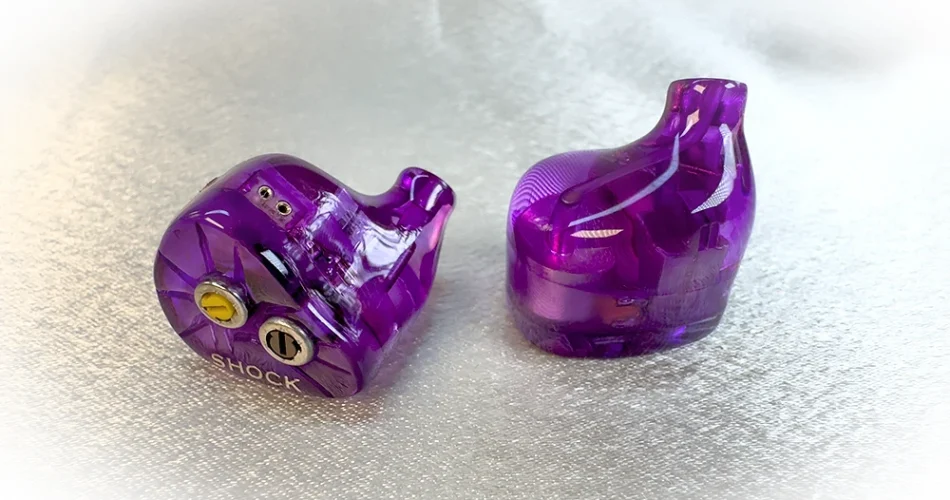IEM Comparisons
I compared the SHOCKs to similar IEMs with a Luxury & Precision P6 Pro HK in hi-gain at 9/60 volume.

ISN H60 – 2xDD 4xBA (USD $349)
The H60’s improved dynamics are immediately noticeable, as is their blacker background and higher resolution across the board.
The H60s are quite a bit brighter and sound clearer & less congested, and despite having a flatter & narrower stage have sharper, more defined instruments with more upfront vocals.
H60 bass also feels a bit faster & more responsible. Whereas the SHOCKs are punchier & meatier with better note weight, warmer but more sluggish at times.
TSMR ARMOR – 2xDD 2xBA 1xEST Hybrid (USD $289)

The ARMORs lack the SHOCKs’ sense of fullness, bass doesn’t hit quite as hard on the stock switch settings & bass texture is a little mushier, note weight is also down.
The ARMORs are more laidback & less bright with a smoother tonality emphasising the lower midrange more, so they’re potentially less fatiguing but the SHOCKs feel more resolving & less congested.
Instruments feel smaller on the ARMORs, dynamics are a bit lower & stage depth is not as impressive.
TSMR X – 2xDD 4xBA 1xPR (USD $399)

Sonically both IEMs are quite similar, but X tends to be smoother & thicker with a more prominent midrange & more elevated midbass, whereas sub bass is diminished and they’re a little darker.
X defintitely spotlights vocals against other instruments more starkly and is tuned to sound more musical, but doesn’t separate instruments as cleanly inside its’ wider, but much flatter stage.
The SHOCKs tend to feel a bit thinner and perhaps shoutier but also more resolving, and thanks to the BCDs instruments are projected further forward of the head.
Simgot EA1000 – 1xDD 1xPassive Radiator (USD $219) with LC7 Cable (USD $69)

The EA1000s’ lower driver count is clearly evident in their lower resolution, greater congestion & occasional difficulty keeping up with fast music.
EA1000 are brighter & more dynamic with far more treble emphasis. Despite their narrower stage, depth is similar. They feel very open & expansive, perhaps thanks to their externally firing passive radiator.
Unfortunately EA1000 treble can occasionally feel metallic and they certainly lack body, at times sounding a little floaty thanks to their Harman tuning.
I visited Addicted to Audio in Melbourne to compare the SHOCKs to IEMs with similar characteristics.
THIEAUDIO Hype 4 – 2xDD 4xBA (USD $399)

The Hype 4s are more energetic with greater upper frequency emphasis, note weight is lower and unfortunately bass lacks the same impact & heft.
Hype 4s’ stage is much flatter, instrument separation can suffer & vocals sound quite lean.
Troublingly Hype 4’s DD also feels more sluggish, and their greater upper midrange emphasis is reminiscent of Harman tuning which I don’t particularly care for.
THIEAUDIO Oracle MKIII – 2xDD 2xBA 2xEST (USD $589)

The Oracle MKIIIs are much more dynamic and portray larger instruments across a broader stage.
Vocals are more forward with slightly higher resolution, imaging is sharper, and they’re also brighter.
The SHOCKs are more musical by contrast, and feel a good deal more raw.
Letshuoer EJ07M – 1xDD 2xBA 1xEST (USD $669)

I find these two IEMs sound somewhat similar, but the EJ07Ms are slightly more dynamic with vocals set further back, and tonally they’re more neutral.
The SHOCKs have greater note weight & bass emphasis, whereas the EJ07Ms have thinner tonality with greater upper midrange presence.
Staging is slightly wider on the EJ07Ms with less warm air between notes resulting in sharper imaging.
THIEAUDIO Prestige – 1xDD 4xBA 4xEST (USD $1299)

As expected given the price difference the Prestige are far more refined, smooth and also resolving.
However I do find their bass somewhat pillowy and treble is quite bright, and it doesn’t always integrate with other frequencies seamlessly as I’d hope for.
Staging is more 3D on the Prestige but bass quantity is lower as is note weight, in general they feel much less grainy & raw than the SHOCKs.
Page 1 – Introduction, Packaging & Ergonomics
Page 2 – Sound Impressions, Technical Performance & Tuning Knobs
Page 3 – IEM Comparisons
Page 4 – Cable Comparisons
Page 5 – Conclusion


Comments